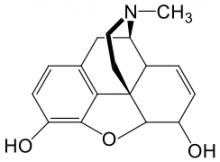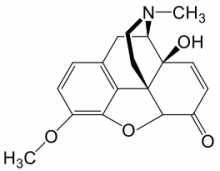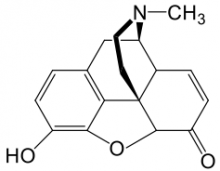Opioids for Treating Pain Associated with Sickle Cell Disease
Jean M. Bidlack, Ph.D.
Common Opioids for Sickle Cell Pain
- Opioids most commonly used to treat sickle cell pain are:
- Morphine
- Oxycodone
- Hydromorphone (Dilaudid)
- Taking prescribed opioid medication for as little as 5 days is a risk factor for dependence or addiction
Morphine
Image

- Used as an analgesic
- Is a potent agonist at the mu opioid receptor
- Multiple routes of administration
- Metabolized by hepatic cytochrome P450 enzymes and glucuronidation into a number of active metabolites
- Excreted by renal elimination
- Chronic use may cause renal disease in sickle cell patients
- May cause respiratory depression and death
- May lead to tolerance, dependence, and addiction
- May cause constipation and urinary retention
- Discontinuation may lead to withdrawal symptoms
- DEA Schedule II drug
Oxycodone
Image

- Used as an analgesic
- Is an agonist at the mu opioid receptor
- Good oral bioavailability
- Metabolized by hepatic cytochrome P450 enzymes into a number of active metabolites
- Some of its metabolites, such as oxymorphone, are more potent than oxycodone
- Excreted by renal elimination
- May cause respiratory depression and death
- May lead to tolerance, dependence, and addiction
- May cause constipation and urinary retention
- Discontinuation may lead to withdrawal symptoms
- DEA Schedule II drug
Hydromorphone
Image

- Synthesized from morphine
- Higher lipid solubility than morphine and crosses the blood-brain barrier more easily than morphine
- Oral bioavailability is very low. Usually used in hospital setting where it is giving by i.v. administration
- Not metabolized by cytochrome P450 enzymes. Metabolized by glucuronidation to hydromorphone-3-glucoronide
- Excreted by renal elimination
- May cause respiratory depression and death
- May lead to tolerance, dependence, and addiction
- May cause constipation and urinary retention
- Discontinuation may lead to withdrawal symptoms
- DEA Schedule II drug

